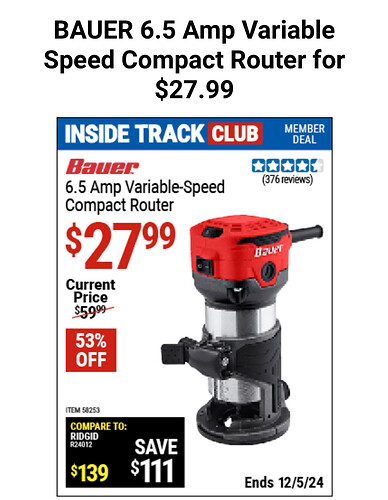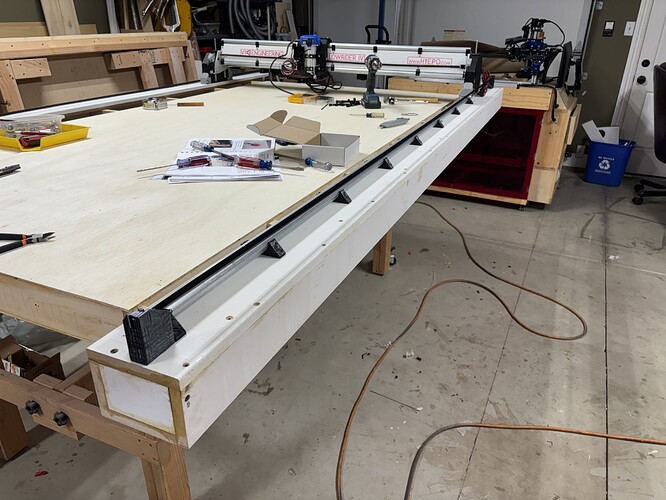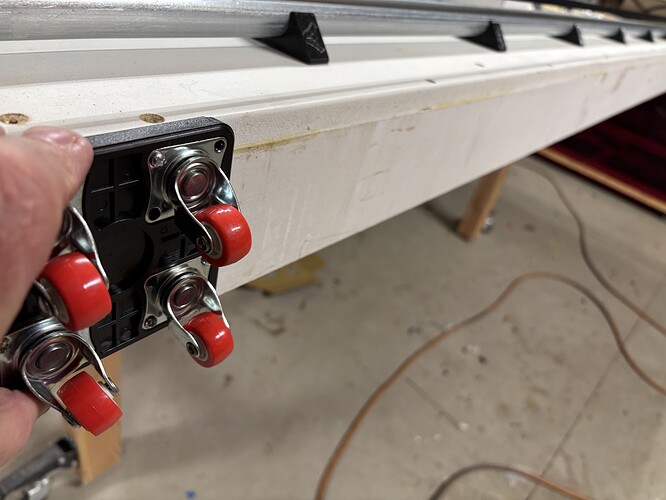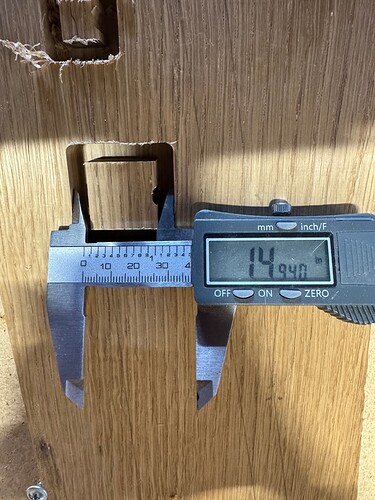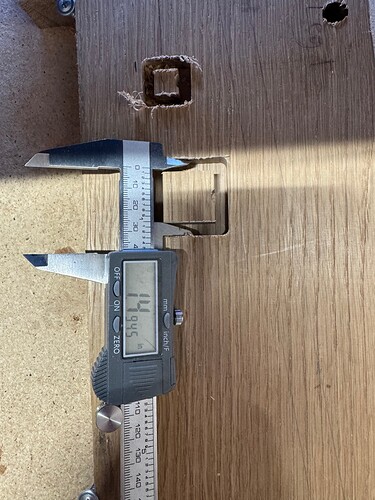Sweet setup! I hope you share more details. Especially intrigued by another Klipper based lowrider.
Looking good!
That looks really great! ![]()
The endmill you are using is really long though. It’s best to choose one with a cutting edge that’s roughly the depth of the cut, because the LowRider is closer to the bottom then and hence more stable. You can then easily go a lot faster and deeper. ![]()
Thanks for the tip! And yes, normally I try and use a shorter end mill, however this was the only 1/4in bit I had at the time.
Most of the time I am cutting out parts from 1in thick hardwoods, so I need a bit with at least 1in long flutes. I do have several shorter bits I have purchased from V1E, but I haven’t gotten a chance to use them yet.
I always cheat and use a 19mm long cutting edge but a tool that sticks out up to 30mm. ![]()
Alright quick question for everyone. As you can see from my pictures, I am using a Harbor Freight Bauer router on my LR4. It has worked great, and given that I only paid $35 for it, I can’t complain.
However, I have come to a point where having an actual handheld trim router would be really nice, without having to remove my current router from my LR4 every time I need to do something by hand. I have been considering getting another Bauer, however they are not on sale right now and are $60.
Two Lowes stores in my area have the Kobalt router still on the shelves, but they are $100, and every time i am at a Lowes, I get an employee to ring up the price to see if it is discounted or not, which they aren’t. ![]()
My question then is: Is there enough benefit from the kobalt router at $100 to justify getting one for my LR4? I think I would enjoy having a better collet system, but how are the other features. I know I would have to print a new mount, but that is not an issue.
Is there any performance gain going for the kobalt? How are the sound levels compared to maybe the makita or other routers? Would it mainly just be a side step rather than a gain for use in the LR4?
Also, any advice on how to get one at a discount? I know people were finding them for like $30 around the US, however all the ones I have seen have still been $100.
The Kobalt has a soft start circuit. That and the ER11 collet are the main advantages, IMO. Noise wise when operating they are similar.
Some people have reported that the Makitas get hot operating for extended times at low settings. I never had that problem, but was probably operating at higher RPM than I should have been.
For the $100 though, I’d buy the Makita.
Well, looks like my decision was made for me. I will be getting at least 1 if not 2 more of these. Might even take one apart and try and paint over the red to make it match my LR4.
For that price. I’d buy another. I had no issues with the last one.
That’s so incredibly cheap, I wonder how they make money…
Because we go in there and end up buying the high margin crap while finding the loss leader crap.
Very true ![]()
![]() . Somehow today I managed to walk out of there with just the router.
. Somehow today I managed to walk out of there with just the router.
Hello everyone, been a while since I’ve posted an update. I’ve been using my LR4 a ton recently for making gifts for the holidays. It has been performing great and I am so glad to have it as another tool in the shop. I have, however, made several changes to my table/setup, and wanted some insight from others. So sorry for the long winded post ahead ![]()
As you can see in my previous posts, I built an enclosure primarily for noise reduction. It worked ok, but the biggest problem i noticed was that the sheet the LR4 was actually sitting on was where most of the noise was coming from. The enclosure itself was sealed very well, but the sheet where all the vibration from cutting was happening was almost like an amplifier, and it would just scream really bad whenever cutting.
I have a feeling this was because it was just mounted to the 2x4 frame of the table it was on, and had no real dampening, but I’m not sure and was curious if anyone had an input on that.
So I decided to take apart my enclosure and try something different. I currently just have the LR4 on its Mdf sheet laying on the concrete floor of my garage, and the noise level is significantly lower. I also made a plywood box around it, that does not actually touch it, and now when running a cut it is about as loud as a fan/AC, which is great.
Given that it is essentially the setup most users term “the bootstrap” phase, I was wondering if anyone had ideas for a more permanent version of this. I enjoy having the machine on just a single sheet so I can lay it on the floor wherever I need it, flip it up vertical for storage, or put it on a table. Are there any downsides to having the machine only mounted to a single sheet rather than having it mounted on a table?
I built a facsimile of a combo of Doug’s and Ryan’s torsion box tabletop… with the intent of being able to store it on long edge. I have the top off the ground on another mobile workbench and have not attempted to slide it off onto its side (rail side) which also will have swivel wheels so I can move it around easily. I guess when I actually mount the swivel wheels and slip it off will I know how well it works. ![]()
(got these off temu pretty cheap)
I’ll advise some sort of latching mechanism so it latches to the mobile workbench securely but right now it’s just sitting there
In the industrial CNC world, often the CNC table of the machine is massively heavy, because (at least in part) the mass is a way to dampen vibrations.
Vibration is absolutely a cause of sound. In musical instruments it’s the goal. In CNC machines, it’s an unwanted noise.
I’ve seen videos where amateur CNC makers poured concrete or epoxy mixed with sand, into cavities in the frame of their table, to add mass.
For the intended use of a LowRider (not milling/hogging out massive amounts of steel, etc), my experience has been that my full size table is heavy enough and sturdy enough that I don’t get much problem with vibration making the spoil board into a drum. But, I have a 1/2" of MDF screwed on top, as the spoil board, screwed down to another 1/2" of MDF that is the top skin of my torsion box, which is itself of course screwed to the torsion box, which has 1/2" OSB for bottom skin, and all that is screwed down to two previous tall torsion boxes attached to each other laterally, all held up by legs made of lumber. And there’s a shelf near the bottom. I have a considerable about of supplies and tools stored inside the tall twin torsion boxes, and on the full size shelf at the bottom. My table is heavy. But no matter how heavy the table is, if its topmost layer is permitted to act like a drum head, I think you still can get loud noise. My two sheets of MDF at the top, seem to be key in me not getting bad vibrations.
PS: If I had it to do over, I’d have the order be: 1/2" MDF spoil board, then 1/2" OSB top skin, and then 1/2" MDF bottom skin (or maybe even 1/4" MDF bottom skin, or 1/8" hardboard bottom skin). The OSB can hold screws for material handling much better than MDF!
Regarding the Lowes’ Kobalt routers, I spoke with a manager a number of month ago and pointed out that they were discontinued. Ended up buying four of them for $50 each. -Steve
Well once again made some changes to my LR4 setup,
or something similar to this to lay under my LR4 when it is on a table in an attempt to keep the vibrations low. I have a hard time thinking it would allow the vibrations to come through as it is 3/4in of solid rubber. Was wondering if anyone has an experience with this type of material not only for CNC work but just in general. If I do end up getting some I will let everyone know how it works.
Even though I have spent a lot of time messing around with making a good setup, I did actually use the machine a little bit. Leading up to Christmas time it was working hard making the many gifts for family and friends, and I noticed maybe a slight wobble in the core, but nothing too crazy. Well it turns out the top 2 bearings on the core I had not even tightened down. They were somewhat snug, but nowhere near where they needed to be. After tightening them, it really made the core solid and it does not wiggle around like it used to. ![]() . I am not sure if they came loose, or (more likely) I never properly tightened them in the first place. I also checked all my other bolts on the machine and snugged them up, and now everything feels super rigid.
. I am not sure if they came loose, or (more likely) I never properly tightened them in the first place. I also checked all my other bolts on the machine and snugged them up, and now everything feels super rigid.
This gave me way better results for cutting as well. I was able to use my 1/4in, 1in long endmill with a 4mm DOC and around 600mm/min speed and it cut great. I have seen other folks going much faster, however, before this I could barely get 2mm DOC without some problems.
I cut out some test squares in white oak, which is a fairly hard wood, and I got pretty dang close to the expected 1.5in. Not perfect, but honestly more than good enough for my use case.
I did have one question for anyone that uses fusion 360 for their CAM. Regarding a finishing pass, I tried it out for the first time on this test square, and I am not sure if the finishing is in regards to the “sidewalls” of this test square, or to the bottom depth that it cut down to. As far as my understanding, for something like this square, a finishing pass would just barely touch the outer walls, taking off very little material to get it to dimension. However, in fusion 360, when doing a 2D contour, I think it is actually trying to finish the bottom depth. Which is a good thing, but I think the sidewalls would be more important, particularly when doing through cuts where the bottom will be gone anyways. If anyone has an experience with finishing passes in fusion, I would love to know how it actually works/the proper way to do it.
Once again thanks to the entire forum for being helpful and sharing their experiences.
I think in ESTLcam the finishing pass is only revising the side walls.
Decided to change up the spoil board a bit, and went for the “pvc fence” method. I had seen a few YouTube videos with people using this, and it seems to provide several benefits, so I gave it a shot. I previously would just screw down my workpiece to the spoil board, but that doesn’t work if you are surfacing the entire piece. So far it has worked great on the few pieces I have milled with it. I plan on making some hardwood wedges that will be able to push up on the workpiece and keep it snug. Curious is anyone else has done something similar on their lowrider, and any tips for using it?
Easy- build another LR4, but install a speaker instead of a router, and run same gcode of the job you are running on the other LR4, at the same time
